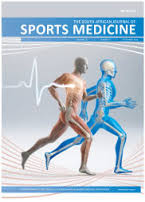Does transversus abdominis function correlate with prone plank and bench bridge holding time in club cricket players?
DOI:
https://doi.org/10.17159/2078-516X/2022/v34i1a12984Abstract
Background: Bridge and plank holding times are used to evaluate core stability. Transversus abdominis (TA) muscle function is assessed using ultrasound and also provides input on an individual’s core stability.
Objectives: A correlation study comparing TA muscle function with bridge and plank holding time in club cricketers.
Methods: Seventeen male, premier league cricketers (age: 22.1 ± 3.3 years) participated in this study. Ultrasound was used to measure bilateral TA, internal oblique (OI) and external oblique (OE) muscle thickness at rest and during abdominal hollowing. Muscle function was measured by means of a Pearson’s correlation as the change in muscle thickness from rest to abdominal hollowing and compared to holding time of the bench bridge and prone plank (seconds).
Results: TA muscle thickness was preferentially recruited bilaterally (p=0.00001) during abdominal hollowing. No significant correlations were found between TA muscle function and holding time for the bench bridge (dominant (D): r = 0.03 [95% CI:-0.46-0.50]; non-dominant (ND): r = -0.02 [95% CI:-0.50-0.47]) or prone plank (D: r = -0.16 [95% CI:-0.60-0.34]; ND: r = -0.13 [95% CI:-0.57-0.38]).
Conclusion: Prone plank and bench bridge holding times are not correlated with TA muscle function during abdominal hollowing. Core stability cannot rely on a single test to evaluate its effectiveness. In particular, the contribution of the local and global muscle system to ‘core stability’ needs to be evaluated independently. Therefore these tests are not sensitive enough to evaluate the contribution of the local muscle system to the global muscle system in a healthy, pain free, sporting population.
Downloads
Downloads
Published
Issue
Section
License
Copyright (c) 2022 South African Journal of Sports Medicine

This work is licensed under a Creative Commons Attribution 4.0 International License.
The South African Journal of Sports Medicine reserves copyright of the material published. The work is licensed under a Creative Commons Attribution 4.0 (CC BY 4.0) International License. Material submitted for publication in the South African Journal of Sports Medicine is accepted provided it has not been published elsewhere. The South African Journal of Sports Medicine does not hold itself responsible for statements made by the authors.
How to Cite
- Abstract 494
- PDF 527






.png)